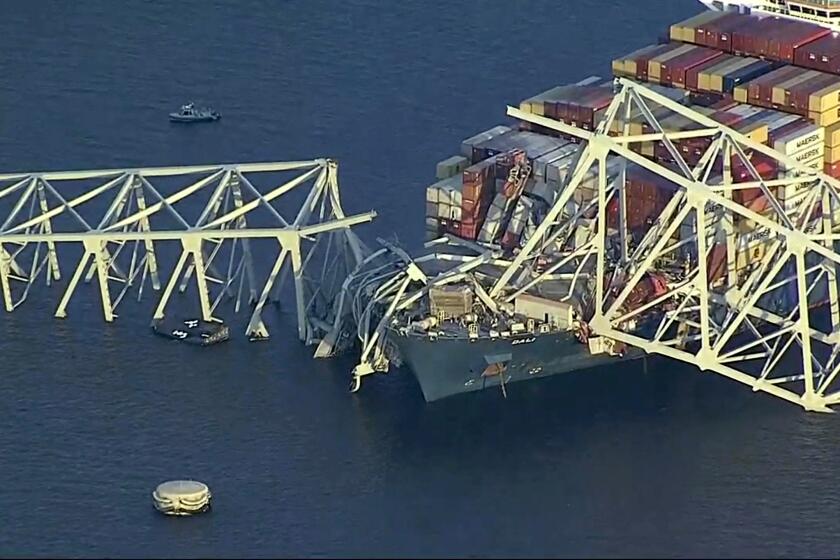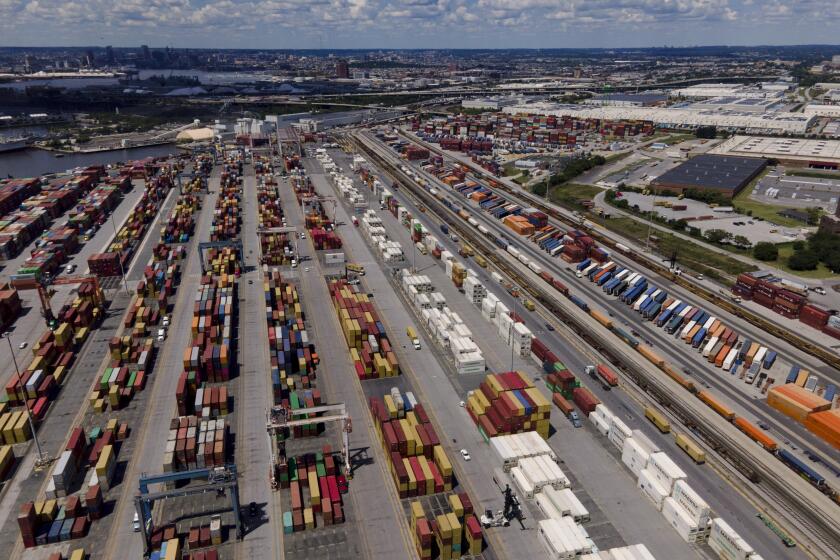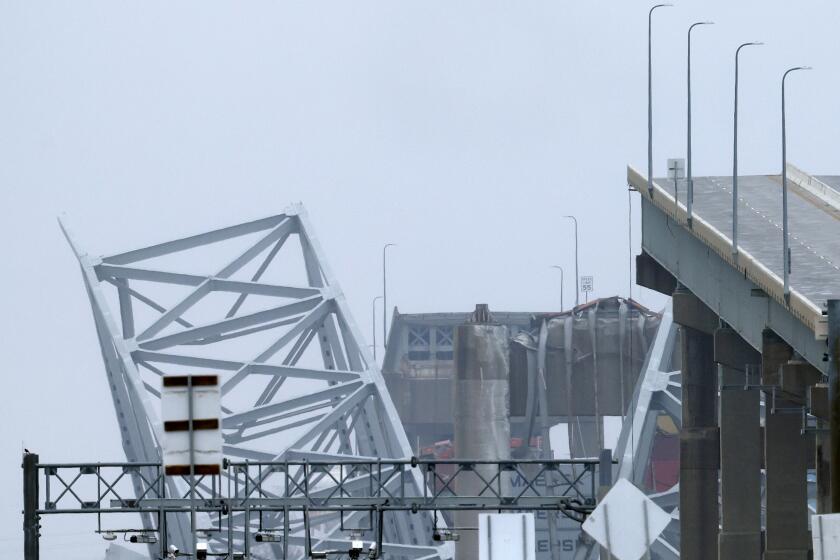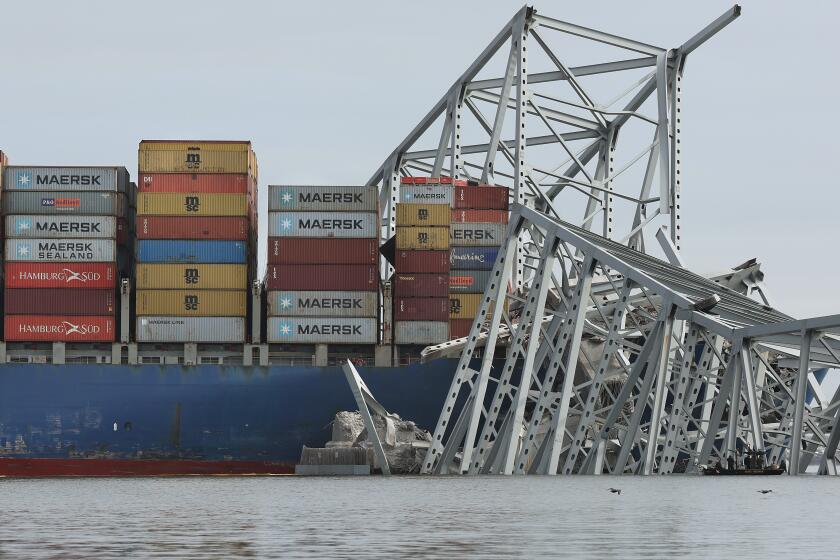Complicated task removing twisted steel, concrete from Baltimore bridge continues
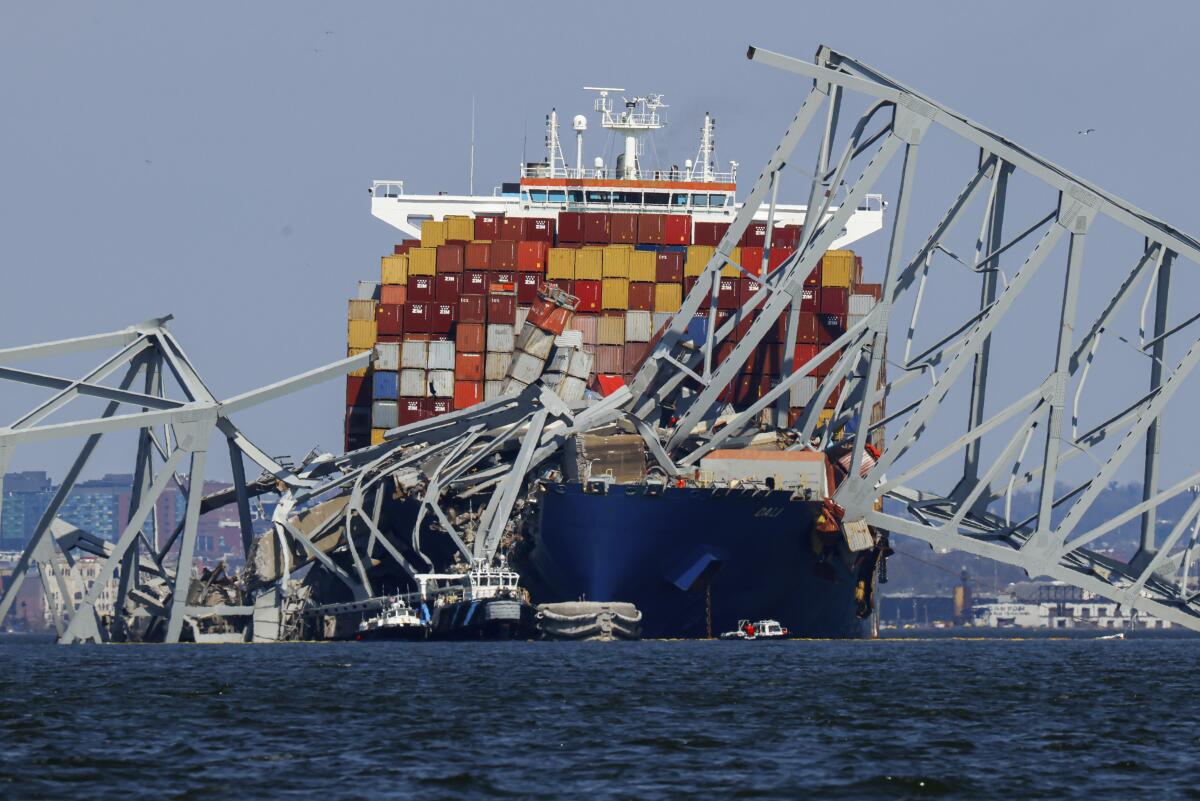
- Share via
BALTIMORE — As crews continued the complicated and meticulous operation of removing the steel and concrete from the fallen Francis Scott Key Bridge in Baltimore, some near the site took time on Easter Sunday to reflect on the two workers who were killed and four others
presumed to have plunged to their deaths.
As cranes periodically swung into place and workers measured and cut the steel to prepare to lift sections of twisted steel, the Rev. Ako Walker said Mass in Spanish at Sacred Heart of Jesus, about five miles up the Patapsco River from the collapse.
“Yes, we can rebuild a bridge, but we have to look at the way in which migrant workers are treated and how best we can improve their situation as they come to the United States of America,” Walker said of the men who were from Mexico, Guatemala, Honduras and El Salvador and were patching potholes.
The bridge fell early Tuesday as the crew of the cargo ship Dali lost power and control. They called in a mayday, which allowed just enough time for police to stop vehicles from getting on the bridge, but not enough time to get a crew of eight workers off the structure.
Immigrants built America, but some politicians and pundits would like us to believe that the great contributions of immigrants stopped somewhere in the late 1800s.
Two workers survived, two bodies were found in a submerged pickup and four more men are presumed dead. Weather conditions and the tangled debris underwater have made it too dangerous for divers to search for their bodies.
Each part of the bridge removed from the water will be lifted onto a barge and floated downstream to the Tradepoint Atlantic logistics center, where it will be inspected, Coast Guard Rear Adm. Shannon Gilreath said.
Everything the salvage crews do affects what happens next and ultimately how long it will take to remove all the debris and reopen the ship channel and the blocked Port of Baltimore, Maryland Gov. Wes Moore said.
It can also alter the course of the National Transportation Safety Board investigation, which, Moore said, is important to ensure this doesn’t happen again.
“We need to have answers on what happened. We need to know who should be accountable for this. And we need to make sure we’re holding them accountable,” Moore said Sunday on CNN.
The collapse of the Francis Scott Key Bridge and the closure of the Port of Baltimore this week could have far-reaching implications all the way across the country for the ports of Los Angeles and Long Beach, according to several experts.
The crew of the Dali, which is as long as the Eiffel Tower is tall, remains onboard the ship. The vessel is tangled in 3,000 to 4,000 tons of debris. Most of its containers remain intact, but a few were torn open or knocked away by the falling debris.
The Dali is managed by Synergy Marine Group and owned by Grace Ocean Private Ltd. Danish shipping giant Maersk charted Dali, which was on its way out of port when it hit the bridge’s support column.
Along with clearing the shipping channel to reopen the port, officials are trying to figure out how to rebuild the major bridge, which was completed in 1977 and carried Interstate 695 around southeast Baltimore and was a vital link to the city’s centuries of maritime culture.
It took five years to build the original bridge. President Biden’s administration has promised to pay the full cost to rebuild, and state and federal transportation officials said they will work as quickly as possible.
Cleanup the wreckage of the collapsed Francis Scott Key Bridge in Baltimore begins and authorities announce suspension of the search for four workers.
But exactly how long the new bridge will take can’t be figured out now. Engineers haven’t been able to assess the condition of the ramps and smaller bridges leading to the collapsed structure to get the full scope of what must be done.
Congress is expected to consider aid packages to help people who lose jobs or businesses because of the prolonged closure of the Port of Baltimore. The port handles more cars and farm equipment than any other U.S. facility.
“This matters to folks in rural North Carolina, in Kansas, and Iowa. This matters to the global economy. And it should not be something that has anything or any conversation around party,” Baltimore Mayor Brandon Scott told CBS’ “Face the Nation” on Sunday. “We are talking about an American tragedy to an American city.”
On Monday, the Small Business Administration will open a center in Dundalk, Md., to help small businesses get loans to help them with losses caused by the disruption of the bridge collapse.
The workers weren’t parishioners at Sacred Heart of Jesus, whose pews were packed Sunday for Mass. But its pastor, Walker, reached out to the families because, as he said, the Latino community in Baltimore is large in number but closely connected.
Experts say the Baltimore collapse does not expose significant vulnerabilities in the major bridges near ports across California. The ports of Los Angeles and Long Beach handle about 40% of U.S. container imports from Asia.
He said they were good men working not just for their families in the U.S., but also for relatives in the countries they came from.
Walker hopes their stories encourage people to embrace migrant workers who want to improve their lives and grow their communities.
“We have to be bridges for one another even in this most difficult situation. Our lives must be small bridges of mercy, of hope, of togetherness and of building communities,” Walker said.
Pesoli and Collins write for the Associated Press. Collins reported from Columbia, S.C. AP writers Sarah Brumfield in Washington ; Kristin M. Hall in Nashville; Adrian Sainz in Memphis, Tenn; and Lisa Baumann in Bellingham, Wash., contributed to this report.
More to Read
Sign up for Essential California
The most important California stories and recommendations in your inbox every morning.
You may occasionally receive promotional content from the Los Angeles Times.
